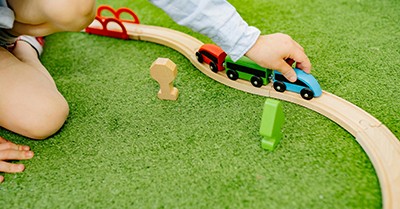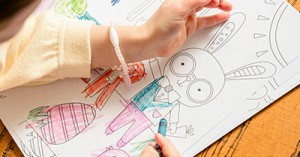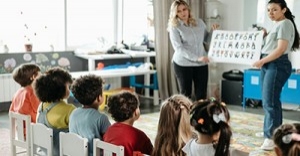The trajectory schema is one of the key patterns observed in schematic play, where children explore movement—particularly the paths objects take when they are thrown, dropped, or otherwise in motion.
What Is the Trajectory Schema?
-
Exploration of Movement: Children repeatedly experiment with moving objects by throwing, dropping, or rolling them. They become fascinated with watching how objects travel along different arcs, speeds, and distances.
-
Understanding Physics Through Play: Through repeated actions, young learners begin to grasp basic scientific principles like gravity and momentum. For example, watching a ball follow a curved path helps them intuitively understand that objects have predictable trajectories.
-
Development of Motor Skills: By engaging in these activities, children refine their hand-eye coordination, fine motor control, and timing—each throw or drop is part of a natural learning curve.
This repeated behavior isn’t just playful; it’s an essential part of how children figure out cause and effect, learn about gravity, and understand the spatial relationships in their world.
How Trajectory Schema Manifests in Play
Consider these common scenarios in early childhood environments:
-
Throwing Games: Children may repeatedly throw small balls or beanbags, intrigued by where and how they land.
-
Object Drops: Kids might be drawn to the act of dropping objects from different heights, fascinated by the fall and the subsequent bounce or roll.
-
Ramps and Slides: Setting up a simple ramp encourages children to experiment, watching how the angle of the incline affects how fast and far an object travels.
Enhancing Trajectory Schema Play
Educators and caregivers can nurture this schema by offering well-chosen materials and creating engaging activities:
-
Provide Varied Materials: Balls of different sizes, lightweight toys, or objects that vary in texture can spark interest.
-
Construct Creative Environments: Use ramps, slides, or even gently sloped surfaces that allow children to experiment with different angles.
-
Ask Open-Ended Questions: Engage with children during play by asking, “What do you think will happen if you throw it from here?” or “Why does it bounce like that?” These questions deepen observation and learning.
-
Rotate Resources: Changing the play materials and settings regularly keeps the activity fresh and encourages new observations and experiments.
Embracing the trajectory schema in early childhood play not only makes learning fun but also sets the stage for a lifelong curiosity about how the world works.
What Activities Can Enhance The Trajectory Schema?
Enhancing the trajectory schema is all about providing opportunities for children to explore the exciting paths objects take when they’re in motion. Here are several practical and creative activities that not only engage children in active play but also subtly introduce fundamental principles of physics and spatial awareness:







 As an Educator in Australia, your pay rate falls under the Children’s Services Award 2010. This award states the minimum amount that an employer can
As an Educator in Australia, your pay rate falls under the Children’s Services Award 2010. This award states the minimum amount that an employer can When working as a qualified Early Childhood Teacher (with a university degree) within a service, your rate of pay will come from the Educational Services
When working as a qualified Early Childhood Teacher (with a university degree) within a service, your rate of pay will come from the Educational Services When working as a Diploma Qualified Educator your pay rate is from the Children's Services Award 2010. This Award states your minimum rate of pay
When working as a Diploma Qualified Educator your pay rate is from the Children's Services Award 2010. This Award states your minimum rate of pay When working as a Cert 3 Qualified Educator, your pay rate is from the Children's Services Award 2010. This Award states your minimum rate of
When working as a Cert 3 Qualified Educator, your pay rate is from the Children's Services Award 2010. This Award states your minimum rate of Educational Leaders play a crucial role in their early childhood service by ensuring that the educational program aligns with best practices and supports the holistic
Educational Leaders play a crucial role in their early childhood service by ensuring that the educational program aligns with best practices and supports the holistic In early childhood education and care, ratios are more than a technicality—they are a frontline safeguard. Every child deserves responsive supervision, emotional connection, and developmental
In early childhood education and care, ratios are more than a technicality—they are a frontline safeguard. Every child deserves responsive supervision, emotional connection, and developmental With the new national child safety reforms kicking in on 1 September 2025, early childhood services like yours have a real opportunity to lead the
With the new national child safety reforms kicking in on 1 September 2025, early childhood services like yours have a real opportunity to lead the Here’s a comprehensive Mobile Phone and Smart Watch Policy tailored for early childhood education and care (ECEC) services in Australia, aligned with the latest 2025
Here’s a comprehensive Mobile Phone and Smart Watch Policy tailored for early childhood education and care (ECEC) services in Australia, aligned with the latest 2025 The Sea of Fish Challenge is a national initiative that invites children, educators, families, and communities to create and display fish artworks as a symbol
The Sea of Fish Challenge is a national initiative that invites children, educators, families, and communities to create and display fish artworks as a symbol Across the early childhood education and care sector, educators are sounding the alarm: current staffing ratios are insufficient to deliver safe, meaningful, and developmentally appropriate
Across the early childhood education and care sector, educators are sounding the alarm: current staffing ratios are insufficient to deliver safe, meaningful, and developmentally appropriate


